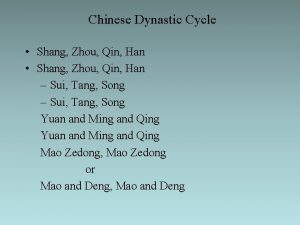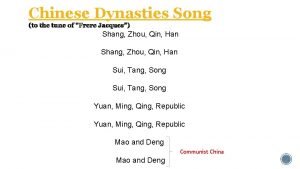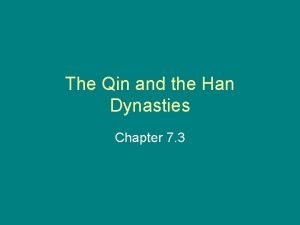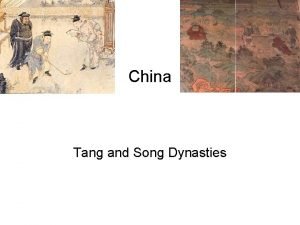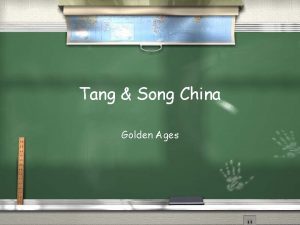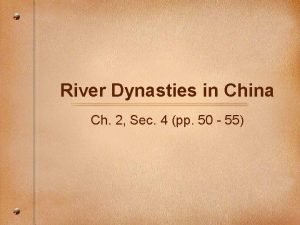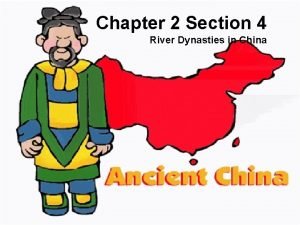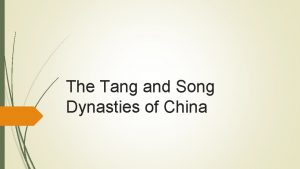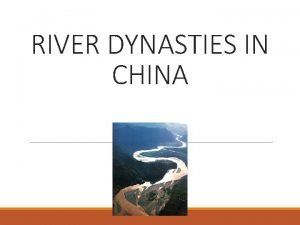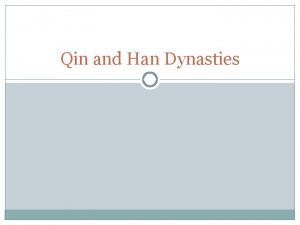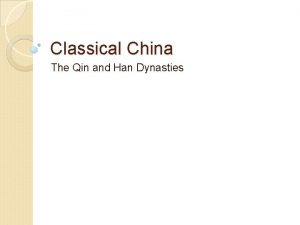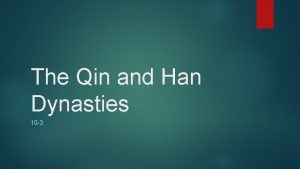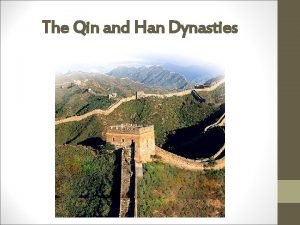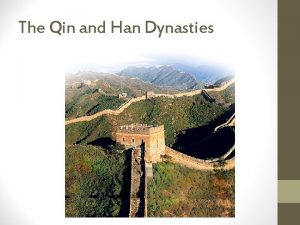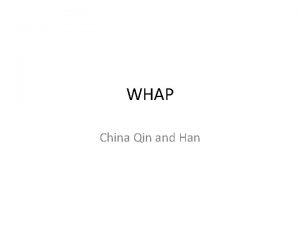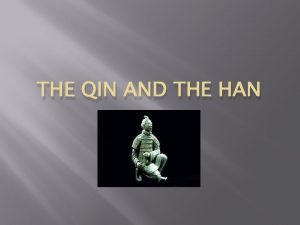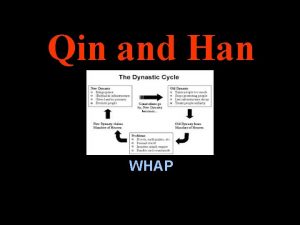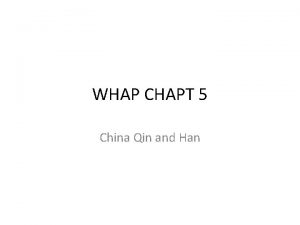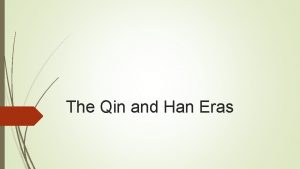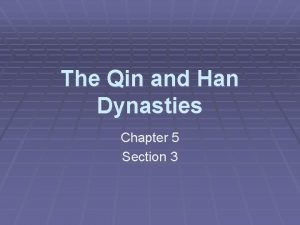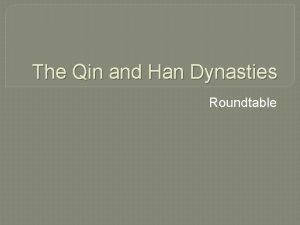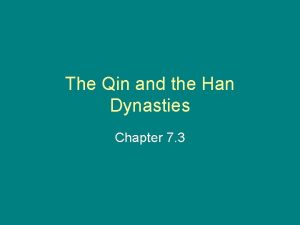Aim How should the Qin and Han Dynasties

















- Slides: 17

Aim: How should the Qin and Han Dynasties be Remembered? Do Now: Each time you come to school late or you forget to do your HW you will have a finger chopped off. How do you feel about this? Write an answer and explain your reasoning. NY State Standards 2 Common Core Standards RS 5, 7, 9, WS 1, 4, 8

Timeline of Chinese History so Far… Shang Dynasty • Shang Dynasty 1650 – 1027 BCE • Earliest Chinese civilization by the Yellow River • Earliest form of Chinese writing • Zhou Dynasty 1027 – 256 BCE • Feudalism • Believed Emperors receive the Mandate of Heaven. Zhou Dynasty If they lost it, then a new dynasty would take over (Dynastic Cycle).

I The Warring States 481 - 221 BCE A) Starting in 481 BBC China consisted of 7 “Warring States”. The Qin under Shi Huangti conquered all 6 enemy kingdoms. B) 221 BCE Shi Huangti declared himself 1 st emperor of China. Shi Huangti

II Qin Dynasty 221 – 207 BCE A) The Qin Dynasty was the first centralized Chinese government to be ruled by an emperor (Shi Huangti). B) Shi Huangti created the 1 st Chinese bureaucracy: - Divided China into 36 districts, each controlled by government officials. - The royal families of the conquered enemy kingdoms were forced to move to the capital city of Xianyang (to spy on them).

Qin Dynasty Continued… C) Achievements: 1. Unified China under 1 Emperor 2. Standardized [made uniform] Chinese written characters 3. Standardized the currency (copper coins) 4. Began the Great Wall of China and the Grand Canal. 5. Terra Cotta “Army” in Xian

The Terra Cotta Army The first Qin Emperor, Qin Shi Huangti, had an “army” of 6000+ life-size statues of soldiers, chariots, horses and weapons buried with him. Each statue’s face is different!


D) Legalism under the Qin Legalism was a philosophical belief that people are naturally selfish, so need strict rules and consequences. 1. It became the official state philosophy of the Qin Dynasty. 2. Harsh punishments (including execution of Confucian scholars) 3. Censorship: burned banned books

Great Wall of China The Great Wall of China is a system of defensive walls and towers. It was built between 476 BCE and 1644 CE to protect China from “barbarians” of the north. 5, 500 miles. The Great Wall of China is often called the “longest cemetery on Earth”, as over 1, 000 workers died while building it. Archaeologists have even discovered human remains buried under sections of the wall.

The Grand Canal (1, 200 miles in length) is the longest man-made waterway. It was begun under the Qin dynasty, but began to be linked together under the Sui.

E) Decline of the Qin In 207 BCE, a peasant army led by Liu Bang seized the Qin capital and began the Han Dynasty (206 BCE – 220 CE) Liu Bang 256 BCE – 195 BCE

III Rise of the Han 206 BCE – 220 CE A) Liu Bang made Chang’an the Han capital. B) Opened China up to trade with the Silk Roads 130 BCE. - A network of overland sea trade routes that connected China to Southeast Asia, India, the Middle East, and Europe. - The West imported Silk and spices from the East. China exported MORE than they imported, but they did import carpets, jewels, and glass. - Culture, religion, language, technology, and diseases traveled the roads as well

Silk Production Silk comes from silk worm cocoons. China kept silk production a secret under threat of death. (China was successful until the Byzantines stole some silk worms in the 6 th century CE) Under the Han Dynasty, silk was sometimes used as currency! Silk was used for clothing (it’s breathable), armor (when tightly woven it’s highly protective, and absorbs sweat), furniture, and art.

C) New Han Technologies 1. Paper: Dried pulverized wood pulp was flattened onto a screen. 2. Acupuncture: Needles inserted into specific points on your body to alleviate pain. 3. Chinese calligraphy developed into an art.

D) The Civil Service Exam 1. Confucianism was the official Han philosophy. To work in the government bureaucracy, you had to pass a civil service exam based mostly on Confucianism. 2. The civil service exam allowed social mobility. Exam takers were locked inside the exam hall for days to prevent cheating. You were not allowed to leave even if ill.

E) Decline of the Han Dynasty 1. Natural disasters, corruption, and peasant rebellions belief the Han lost the Mandate of Heaven. 2. The last Han Emperor abdicated (resigned) 220 CE. 3. China would not unify for another 350 years.

Key Vocabulary ü Acupuncture ü Chang’an ü Civil service exam ü Confucianism ü Grand Canal ü Great Wall of China ü Han Dynasty ü Legalism ü Liu Bang ü Qin Dynasty ü Qin Shi Huangti ü Silk Road ü Terra Cotta Army ü Warring States
 Dynastic cycle
Dynastic cycle Han sui tang song
Han sui tang song Qin han
Qin han Tang and song venn diagram
Tang and song venn diagram Sui tang and song dynasties
Sui tang and song dynasties Golden age of tang and song dynasties
Golden age of tang and song dynasties Sui tang and song dynasties
Sui tang and song dynasties Sui tang and song dynasties
Sui tang and song dynasties How did the sui and tang dynasties reunite china
How did the sui and tang dynasties reunite china Why were the tang and song dynasties golden ages
Why were the tang and song dynasties golden ages 618 song
618 song Conclusion on delhi sultanate
Conclusion on delhi sultanate River dynasties in china
River dynasties in china Chapter 2 section 4 river dynasties in china answer key
Chapter 2 section 4 river dynasties in china answer key Shang dynasty acrostic poem
Shang dynasty acrostic poem Chinese dynasties
Chinese dynasties River dynasties in china
River dynasties in china Song
Song
